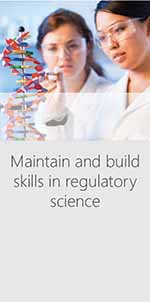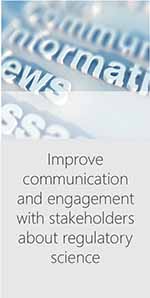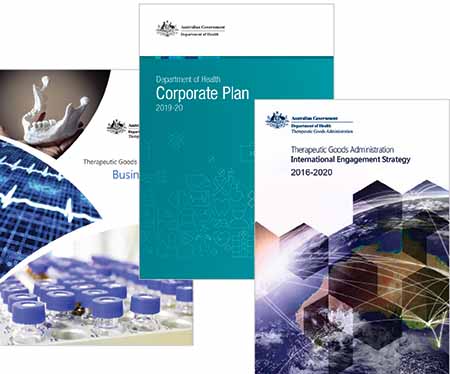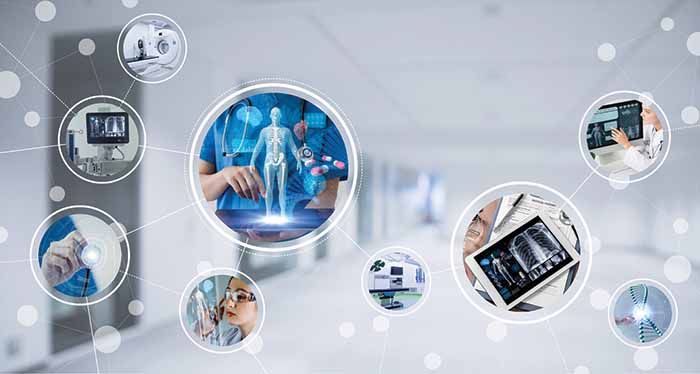
On this page: Foreword | Summary | Introduction | 1. Maintain and build skills in regulatory science | 2. Improve domestic and international collaboration with government agencies, scientific organisations and regulators | 3. Increase responsiveness to emerging technologies | 4. Improve communication and engagement with external stakeholders about regulatory science | Next steps
Foreword
New technologies such as gene therapies, other cell and tissue therapies, 3D-printing, and software as a medical device are transforming the way Australians manage their health, and how medical conditions are treated and prevented. At the same time, the design of clinical trials has changed and new approaches are being applied for gathering and utilising real world evidence. This is the case both for these "new technologies" and for renewed interest in therapies such as those based on medicinal cannabis.

At the Health Products Regulation Group (HPRG), which comprises the Therapeutic Goods Administration (TGA) and the Office of Drug Control (ODC), our vision is better health and wellbeing for all Australians through regulatory excellence. To achieve this vision, we rely on the diverse skills, expertise and knowledge of our regulatory scientists.
It is important that our regulatory scientists remain up to date with the latest health product technologies to ensure that Australians are accessing safe and effective therapeutic products.
I am therefore pleased to share the first HPRG Regulatory Science Strategy which outlines how HPRG will maintain and build its regulatory science capability over the next five years, as we continue to work towards better health outcomes for all Australians.
Adjunct Prof John Skerritt
Deputy Secretary for Health Products Regulation Group
Department of Health
Summary
The safety, quality, efficacy and timely availability of medicines, medical devices, biologicals, combination products and controlled drugs in Australia depend on the decisions of regulatory scientists at the Health Products Regulation Group (HPRG) within the Commonwealth Department of Health. The HPRG comprises the Therapeutic Goods Administration (TGA) and the Office of Drug Control (ODC).
Regulatory scientists in HPRG use highly developed knowledge and skills from a range of disciplines to make, or contribute to, risk-managed and evidence-based decisions about health products.
This document outlines a strategy for how HPRG will maintain and build regulatory science capability over the next five years. It identifies ways to make sure that we continue to make the best possible decisions, and that we are prepared for future regulatory challenges. This will help us meet our vision of better health and wellbeing for all Australians through regulatory excellence.
The strategy is focussed on four key areas:
- Maintain and build skills in regulatory science
- Improve domestic and international collaboration with other government agencies, scientific organisations and regulators
- Increase responsiveness to emerging technologies
- Improve communication and engagement with stakeholders about regulatory science.
Initiatives to address each of the four key areas are proposed in this document, along with preliminary ways to implement them. These initiatives, which will be implemented in a stepwise approach over the next five years, will contribute to the quality of our work and will help build regulatory science capabilities at HPRG.
Introduction
Background
A high quality health system relies on regulation to protect and enhance the health and safety of the community. The Health Products Regulation Group (HPRG) comprises the Therapeutic Goods Administration (TGA) and the Office of Drug Control (ODC). Together, we are responsible for safeguarding and enhancing the health of all Australians through effective, timely and risk-proportionate regulation of medicines, medical devices, biologicals, and controlled drugs.
Purpose of this strategy
Technology is quickly evolving and health products are becoming more complex. This presents a challenge to how we regulate health products.
To make sure that we continue to make the best possible regulatory decisions, we must ensure that our regulatory scientists are capable, collaborative, communicative and responsive to future challenges and emerging technologies.
This document identifies initiatives that will help maintain and build our regulatory science capabilities over the period 2020 to 2025. These initiatives will be implemented in a step-wise approach over the next five years. This will help ensure that we continue to meet our vision of better health and wellbeing for all Australians through regulatory excellence into the future.
This strategy is focussed on four key areas:
 |  |  |  |
Who are regulatory scientists?
Regulatory scientists within the HPRG are highly skilled professionals who apply knowledge and skills from different disciplines to contribute to or make risk-managed and evidence-based decisions regarding therapeutic goods and controlled drugs. Additionally, regulatory scientists contribute to the development of regulatory standards, tools and policies.
Our regulatory scientists have a wide range of professional, scientific, technical and clinical training and expertise. This includes people from a range of fields, including chemists, biologists, immunologists, toxicologists, health professionals, laboratory technicians, and engineers. This knowledge and expertise is critical for the Department of Health to perform our regulatory and compliance monitoring responsibilities.
Strategic framework
This strategy aligns with the TGA business plan 2019-20, which sets out our product regulation, regulatory reform, international engagement and regulatory compliance agenda for 2018-19 and the steps we are taking to achieve this agenda. It supplements the Department of Health Corporate Plan - external site and is supported by the TGA International Engagement Strategy 2016-2020.
The strategy aligns with the HPRG vision statement:
"Better health and wellbeing for all Australians through regulatory excellence"

1. Maintain and build skills in regulatory science

Two focus points are essential to HPRG maintaining, supporting and building skills in regulatory science to meet future needs:
Training and development
Training and development opportunities allow our staff to maintain their scientific expertise and further develop their skills to meet future challenges. This is proposed to be accomplished by the initiatives outlined below.
HPRG Regulatory Science Capability Framework
Development of a Regulatory Science Capability Framework (RSCF) will identify the capabilities needed for regulatory scientists within the HPRG. The RSCF can be used by managers for team development, for individual career progression planning and to assist with recruitment criteria. Managers will also have the opportunity to use the framework to identify capabilities at particular proficiency levels against job functions for their area.
The RSCF will complement the Integrated Leadership System (ILS) - external site. The RSCF will be developed to connect the non-technical nature of the ILS with our technical work. In this way, it can be used in conjunction with other existing public service frameworks. To undertake this task, we will convene a working group to develop, verify and test the framework. This group will also be responsible for internal consultation to ensure the RSCF meets the intended purpose.
Continuing Professional Development for regulatory scientists
A formalised Continuing Professional Development (CPD) program open to all regulatory scientists will contribute to our culture of ongoing learning and development. This program will be voluntary and will help staff keep up-to-date with technical knowledge and developments, and help build regulatory science skills in key strategic fields.
A CPD program will recognise proactive learning, and actively demonstrate the value of specialised regulatory science knowledge within the group. Additionally, it will complement existing programs, such as CPD for medical officers.
To implement a CPD program, an internal working group will be established to develop formal outcomes for participants, such as formal recognition of annual program completion. The working group will also develop a points system associated with professional development activities, such as technical reading and attending presentations and conferences. Additionally, the working group will develop an online reporting system for staff to record their CPD points.
This will give managers visibility of their staff's progress in the CPD program.
Regulatory science conference
A regulatory science conference hosted by HPRG will enable staff in the Department to access world-leading experts across disciplines of regulatory science. This will be an effective and efficient way to provide training and development to address emerging technologies in the health product field.
The conference will be internally focussed and available to all Departmental staff. The event will be organised internally and topics selected by an organising committee. Speakers could include internal staff and external subject matter experts, for example Australian or international academic experts. It is anticipated that the conference will be a one-day event that happens every two years.
The conference will also complement existing training and development opportunities such as the Regulatory Science Network (RSN) and ARCS Australia conferences.
Attracting and maintaining workforce
Skills audit
As part of workforce planning activities, a periodic audit of regulatory science capabilities in each business area will provide a picture of the current regulatory science capability. This inventory of skills will identify particular skills and qualifications relevant to work in HPRG. This inventory will be compared with the skills required to undertake the work in branch business plans. The use of a gap analysis will further inform workforce planning activities.
Career progression and upskilling existing HPRG staff
Using the skills audit, priority skills will be identified in business plans and workforce plans. Depending on the complexity of the skill and urgency of the requirement, skills can be gained through peer training, short training courses or tertiary education options. These priority skills will be the focus of internal and external collaborative knowledge-sharing, conference hosting and attendance.
Through discussion with their managers, regulatory scientists will be able to use the Regulatory Science Capability Framework (RSCF) to recognise their own skill gaps and development needs to become more effective in their role. This will complement development of specialist skills and form part of their individual development plans (IDP).
2. Improve domestic and international collaboration with government agencies, scientific organisations and regulators

Collaboration enhances regulatory science by:
- bringing together people from diverse backgrounds
- exposing regulatory scientists to new ways of thinking and problem solving approaches
- encouraging improved and innovative solutions
- facilitating faster progress in achieving common goals.
Collaboration involves HPRG regulatory scientists engaging with other regulatory scientists, organisations, and other groups from a wide variety of sectors in a non-commercial, non-competitive way to share information.
It is important that regulatory scientists in HPRG receive opportunities to build, develop and enhance strong and collaborative networks to fully realise the benefits of these partnerships. This can be achieved by developing a culture of collaboration and information sharing.
Enhance collaboration
The HPRG has existing collaborations with various Australian Government and international agencies, scientific organisations and regulators. These foster a collaborative culture of information sharing amongst regulatory scientists. Collaborations can be further improved and fostered by initiating and enhancing collaboration with:
- other areas of the Australian Department of Health
- Australian Government (scientific) regulatory agencies
- Australian Government (non-scientific) regulatory agencies
- Australian scientific organisations including universities and research bodies
- Australian professional societies
- international regulatory agencies, particularly regulators of health products.
Identifying collaboration partners
The following key principles have been developed to identify collaboration partners with the HPRG:
- What are the aims of the organisation? - Do they align?
- What strategies does the organisation employ to accomplish their goals? - Do they align or complement?
- Who have they collaborated with in the past? - Are there existing mutual links?
- What level of collaboration is the organisation offering? - How committed are they to the collaboration?
- What is in it for them? - What will the organisation gain from the collaboration (and similarly, what will the Department?)
Improve links with academia
Developments in health product technology are often pioneered by academic researchers. Building better links with educational and research institutions will help us to understand emerging scientific developments and to access the technical expertise of academics. This will expose regulatory scientists to other ways of thinking and different problem solving strategies to answer the potential regulatory science challenges of the future.
Building relationships with academia will assist focussed recruitment. As relationships progress, specific course content can be developed in collaboration with current HPRG staff to better equip those seeking careers in regulatory science, improving career pathways to positions in regulatory science organisations.
Participation in career weeks for universities that deliver education in relevant regulatory science areas will enable engagement with students and potential regulatory scientists.
Collaboration in practice
HPRG has a substantial national and international presence through collaborative arrangements with other national regulatory agencies. Additionally, we have ongoing membership on numerous international working groups including the International Coalition of Medicines Regulatory Authorities (ICMRA), the International Medical Device Regulators Forum (IMDRF) and the International Pharmaceutical Regulators Programme (IPRP). We are also a key member of the Regulatory Science Network (RSN), a network of Australian government regulatory science agencies that aims to foster linkages between regulatory agencies. This strategy supports the continuation of such collaborations.
3. Increase responsiveness to emerging technologies

Identifying scientific developments early is important if we are to respond effectively to emerging innovations. These innovations occur largely outside of government. Therefore, we need to improve our awareness of scientific innovations and the types of therapeutics that may result from these future innovations.
The rapid pace of developments in health product technology has led to new and complex products, treatments and diagnostics. Forecasting trends will enable us to adapt quickly to these developments. Awareness of key trends in science will facilitate prioritisation and focus on accessing knowledge and expertise in those fields.
A formal, structured mechanism to capture and assess these technological advances will increase our awareness and responsiveness to relevant emerging health product innovations and technologies.
HPRG Regulatory Scientist Forum
An internal Regulatory Scientist Forum (RSF) will proactively promote systematic exploration and management of emerging technologies. The forum will contain representatives from branches across HPRG to ensure that a diversity of knowledge and expertise is effectively harnessed.
RSF members will be tasked with addressing three aims:
- Identify emerging technologies and expand capacity to identify emerging technologies
- Improve management, assessment and analysis of emerging technologies
- Accelerate response to identified technologies.
Members will horizon scan by actively monitoring scientific literature to seek out emerging technologies and trends, primarily new discoveries in the development of health products from the biomedical, pharmaceutical and medical devices industries. This will involve systematic examination of potential developments on the margins of current thinking and will explore novel and unexpected fields of research. This information will be entered into a database to capture the information and its relevance to HPRG. Management of the database will form a reliable indicator of future regulatory requirements and approaches and will inform potential capability gaps.
The RSF will also be responsible for communicating emerging health product technologies, including the potential risks they pose and mitigation strategies. This could be in the form of a regular report written for internal dissemination and seminars given by forum members to internal staff.
A strategy is presented below for how the RSF will gather, assess, and share intelligence to plan for emerging technologies.

- Intelligence gathering
- News
- Consumer opinions
- Scientific literature
- Industry intelligence
- Conferences
- Assessment
- Evaluation
- Inspection
- Database entry
- Relevance to HPRG
- Information sharing
- Formulate response
- Database entry
- Escalation (if needed)
- Educate others
- Support decision making
- Future planning
- Filling knowledge gaps
- Identify experts to provide advice
4. Improve communication and engagement with external stakeholders about regulatory science

Effective and purposeful communication and engagement with our external stakeholders about regulatory science is critical to:
- improve understanding and confidence in how we use regulatory science to make decisions
- ensure stakeholders can make informed decisions about issues that affect them.
The contribution and feedback obtained through meaningful engagement of external stakeholders with diverse experience, knowledge and opinions is important to ensure we continue to make the best possible regulatory decisions.
Improving communication and engagement with external stakeholders about regulatory science will help us:
- understand how to strengthen and increase relationships with our external stakeholders
- proactively provide evidence-based regulatory science information in language our stakeholders can understand
- develop a communication and engagement ethos that improves trust and confidence.
Effective communication
Technical details are important to us, but need to be effectively communicated to others to build understanding of the importance of our work.
To do this we need to provide information that is:
- timely
- accurate
- understandable
- clear
- respectful.
We regularly provide credible scientific information that helps to inform consumers, professionals and others to reduce the spread of misinformation. This is important to ensure that the Australian public has correct information based on trustworthy and reliable sources.
Effective communication of regulatory science means that:
- consumers can make more informed decisions about issues affecting them
- health professionals can be better informed about health products and what they can do to support our regulation of health products
- companies can be clearer about our processes and reasons for decisions.
Some initiatives to improve the effectiveness of our communication of regulatory science are detailed below.
Provide clear evidence-based information
HPRG has several avenues for communicating information to a wide variety of external stakeholders. Online channels like the TGA website, TGA topics blog, TGA Facebook page - external site and the Office of Drug Control website - external site can be leveraged to communicate clear evidence‑based regulatory science information in a timely manner. This includes communicating outcomes from the HPRG Regulatory Science Forum on emerging technologies to our external stakeholders.
HPRG regulatory scientists will continue to:
- advocate the communication of regulatory science information for key public health issues and decisions
- strive to ensure that all regulatory science communication is appropriately targeted to audience understanding and followed up to evaluate effectiveness.
Improve trust and confidence
How we communicate with internal and external stakeholders is important for improving their trust and confidence in how decisions are made. Our work is complex and full of uncertainty and risk. It is our job to ensure that we maintain trust and confidence when communicating such uncertainties and risks.
The communication and engagement of our regulatory scientists will be guided by the Department of Health's principles for stakeholder engagement - external site: purposeful, inclusive, timely, transparent and respectful.
We will continue to monitor and evaluate the effectiveness of our communication and engagement strategies as we strive to improve internal and external stakeholder trust and confidence.
One method of achieving this is by providing short summaries of our regulatory decisions made in consumer-friendly format. This could be similar to the summaries published by Health Canada and the European Medicines Agency.
Next steps
This document identifies a number of initiatives with an aim to maintain and build our regulatory science capabilities over the period 2020 to 2025. The next step to achieve this goal is to develop an implementation plan, which will:
- identify initiatives with highest priority
- outline measures of success for the initiatives
- plan a timeline for implementing the initiatives
- determine risks and mitigation strategies.
Implementing these initiatives will occur in a step-wise approach over the next five years. The implementation approach will be prioritised based on initiatives that most contribute to making the best possible regulatory decisions, and initiatives that best prepare us for future regulatory challenges. This approach will help us meet our vision of better health and wellbeing for all Australians through regulatory excellence.

